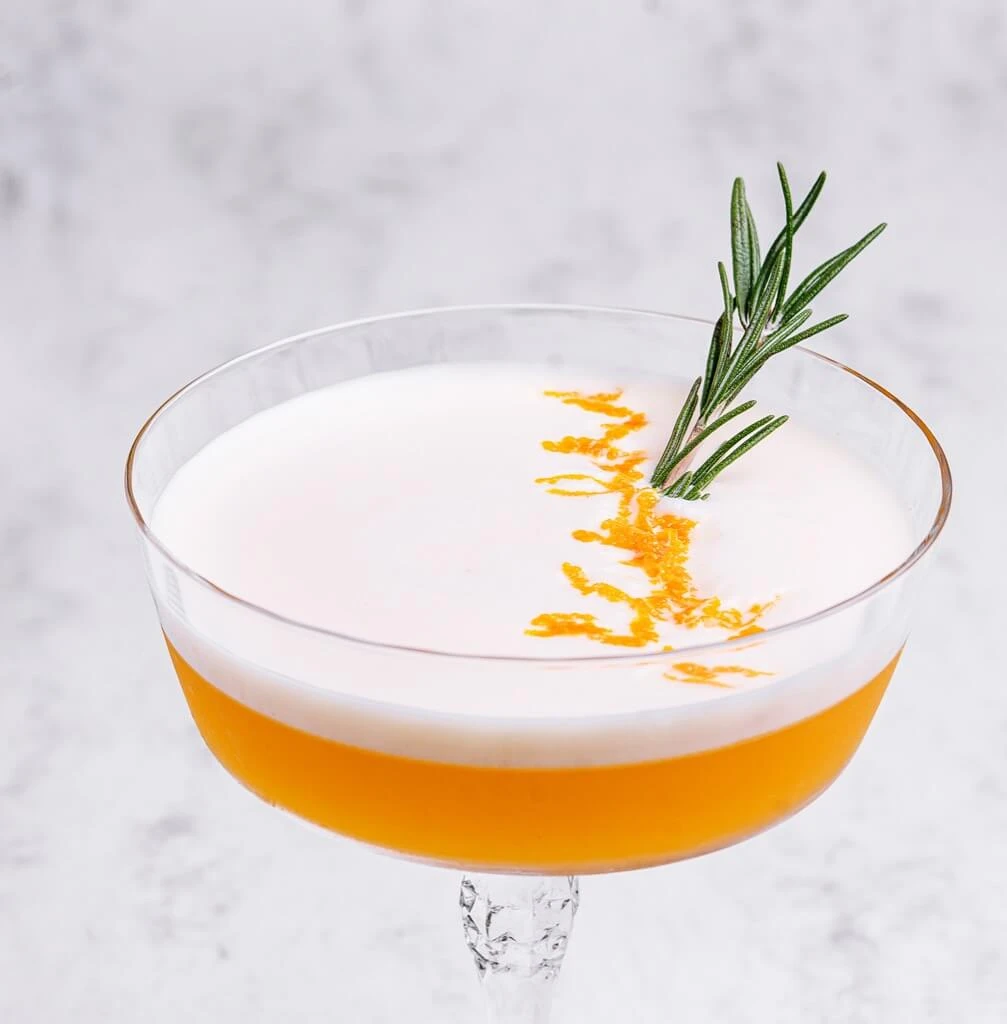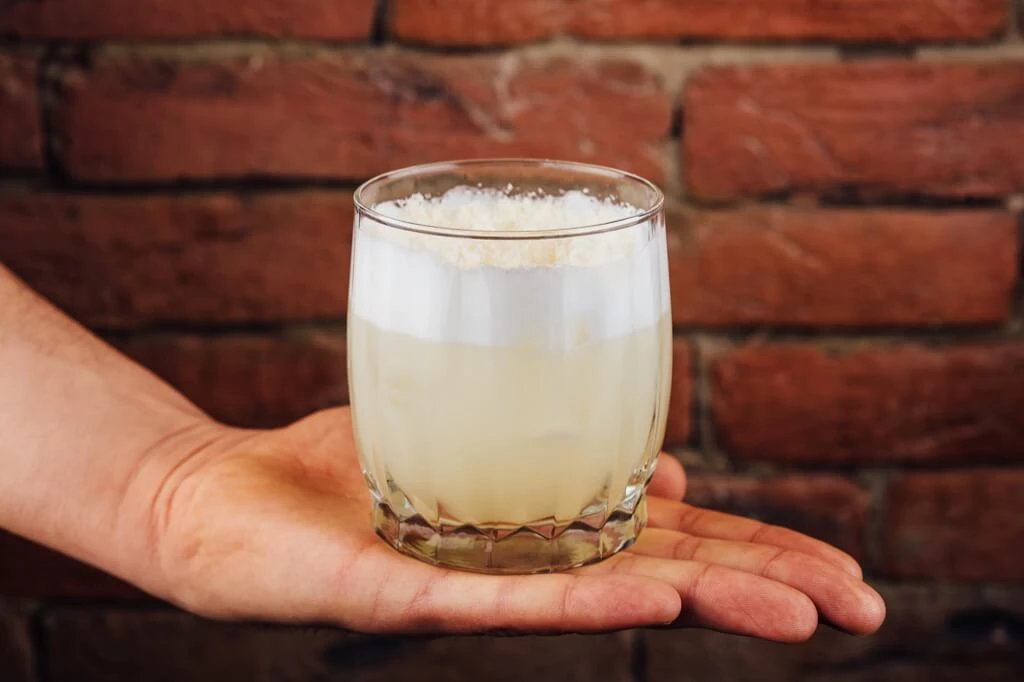If you’ve ever watched a bartender crack an egg, add the whites to a shaker, and then serve the drink—completely uncooked—you might have had a moment of hesitation. After all, we’ve been warned about the dangers of eating uncooked eggs, right? We can shed some light on the use of egg whites in cocktails and why they’re worth exploring.
Why use egg whites in cocktails in the first place? There must be a good reason, and indeed, there is. Egg whites add a unique dimension to cocktails, making them silkier and fuller, resulting in exceptionally smooth drinks. They also have the remarkable ability to muffle strong flavors, providing a well-balanced taste profile. That’s precisely why they are a common ingredient in classics like the Whiskey Sour and other sour cocktails, as they help to balance out the acidity of citrus.
Still not convinced? Let’s take a closer look at how egg whites transform a cocktail. We even have a video demonstrating the difference between making a cocktail with and without egg whites.
Pomegranate Margaritas
We conducted a little experiment to showcase the impact of egg whites in cocktails. Our test subjects were Pisco Sours, daiquiri, and whiskey sours, one with egg whites and one without. Here’s the recipe:
- 2 ounces of Pisco Brandy
- 1 ounce of Lime Juice
- 3/4 ounce of Simple Syrup
- 3/4 ounce of Egg Whites (approximately the whites of one egg)
- A few drops of Angostura Bitters for garnish
Without Egg Whites:
- The cocktail lacks visual appeal with no froth.
- It has uniform coloration but doesn’t stand out.
- The taste is decent but lacks harmony, requiring adjustments to the citrus or sugar.
With Egg Whites:
- The cocktail boasts a beautiful white froth on top.
- It becomes visually appealing and allows for creative garnishing.
- The egg white protein softens the acidity of the citrus, creating a well-balanced cocktail.
Classic Daiquiri
- 2 ounces of White Rum
- 1 ounce of Fresh Lime Juice
- 3/4 ounce of Simple Syrup
Without Egg Whites:
- The cocktail appears clear and simple.
- It maintains its classic pale yellow color.
- The taste is crisp and citrusy but lacks depth.
With Egg Whites:
- The cocktail is transformed with a luscious white foam topping.
- The foam contrasts beautifully with the pale yellow base.
- Egg whites add a velvety texture and soften the sharpness of the lime, resulting in a harmonious and well-balanced flavor.
Whiskey Sour
- 2 ounces of Bourbon Whiskey
- 3/4 ounce of Fresh Lemon Juice
- 1/2 ounce of Simple Syrup
Without Egg Whites:
- The cocktail lacks visual interest with no froth.
- It maintains its whiskey-like hue.
- The taste is sour but lacks the creamy texture and complexity.
With Egg Whites:
- The cocktail showcases a creamy, frothy crown.
- The white foam contrasts elegantly with the amber whiskey.
- Egg whites bring a silky texture and balance to the sharpness of the lemon, elevating the overall flavor profile.
Clover Club
- 2 ounces of Gin
- 3/4 ounce of Fresh Lemon Juice
- 1/2 ounce of Raspberry Syrup
- A few Fresh Raspberries for garnish
Without Egg Whites:
- The cocktail appears clear and transparent.
- It retains its pale pink hue.
- The taste is fruity but somewhat flat.
With Egg Whites:
- The cocktail transforms with a luxurious pink foam topping.
- The foam adds vibrancy to the pale pink base.
- Egg whites introduce a velvety texture and elevate the fruitiness, creating a more satisfying and visually appealing cocktail.
Apart from their unique silkiness and flavor enhancement, egg whites offer another compelling reason to consider using them in your cocktails. They provide a clean canvas against which both modern and vintage cocktail garnishes can shine.
What’s Your Garnish Game?
By incorporating egg whites into your cocktails, you create a stunning backdrop that enhances the visual appeal of garnishes. Here are some creative garnishing ideas for your next slots gaming evening:
- Craft your cocktail stencils or purchase them for added decoration.
- Decorate the cocktail’s surface with floating rinds, petals, or fruit skins in intricate patterns.
- Use a toothpick to create patterns with colored liqueur or bitters on the egg-white foam.
Secrets to Perfect Egg White Cocktails

Now that we’ve piqued your interest in using egg whites, let’s discuss how to do it safely and effectively. There are a few key details to keep in mind:
To achieve excellent foaming results with egg whites, you’ll need to make a slight adjustment to your shaking technique. While the standard procedure for making cocktails is to “dry shake” (shake without ice) before adding ice and shaking again, using egg whites extends the shaking time. This double-shaking approach is crucial for achieving the characteristic velvety texture of egg white cocktails.
In recent times, bartenders have adopted a variation of this technique known as the “Reverse Dry Shake.” It involves shaking the cocktail as usual, then straining it and shaking it “dry” (without ice). The result? More foam and more flavor. Both methods yield excellent results, with slight differences. The classic “dry shake” produces thicker, smoother foam, while the reverse dry shake creates larger bubbles in the foam. Your choice should be based on personal preference and the characteristics you seek in your cocktail.
Safety is a paramount concern when using raw egg whites in cocktails. Your mother’s warnings about consuming uncooked eggs were not unfounded. However, with proper precautions, the risks can be significantly reduced. Here’s how to ensure safety:
- Use only fresh and clean eggs for raw egg cocktails.
- Incorporate citrus and alcohol into raw egg cocktails; they have sanitizing properties.
- Always inform your customers if a cocktail contains raw eggs to accommodate allergies or safety concerns. This is not only considerate but may also be a legal requirement in some areas.
Egg-white cocktails are best enjoyed when chilled, as they taste even better. However, as they warm up, the aroma of eggs becomes more noticeable, and not in a pleasant way. To avoid this issue, consider rimming your glass with citrus rind and spritzing your egg white beverages with citrus oil. The additional aromatics from the oil will mask the egg scent, giving you more time to savor your drink.
Alternatives to Egg Whites in Cocktails
If you’re still not comfortable using raw eggs in your cocktails or catering to vegan preferences, you’re in luck. There are alternative methods to achieve frothy cocktails without eggs. Let’s explore a few options:
1. White Egg Powder
While not suitable for vegans, white egg powder is a healthy alternative that closely mimics the properties of egg whites. It’s safe to use due to pasteurization and provides nearly identical results. Plus, it’s readily available and affordable.
2. Aquafaba
Aquafaba is a vegan-friendly alternative that doesn’t use any animal products. It’s obtained from the liquid found in cans of chickpeas, and it can produce a tasty cocktail foam. Though it requires longer shaking and a dry shake beforehand, the results are impressive. Aquafaba doesn’t impart a bean flavor to your drink and lacks the egg odor, making it a compelling alternative.
3. Versawhip
Versawhip is a vegan option made from soy proteins. It does have a slightly metallic and bitter flavor, which can be masked with sugar or flavorings. However, it requires additional steps for foam production, making it less convenient.
So, there you have it! The secret behind those velvety, foamy cocktails is none other than our trusty egg white. But before you dive headfirst into your next mixology adventure, you might be wondering, “Is this egg-citing test worth it?”
Well, picture this: you’re sipping on a perfectly balanced Whiskey Sour, its frothy crown like a fluffy cloud atop your glass. The flavors dance on your palate, and you can’t help but smile. The question isn’t whether egg whites belong in cocktails; it’s more like, “Why haven’t I been using them all along?”

